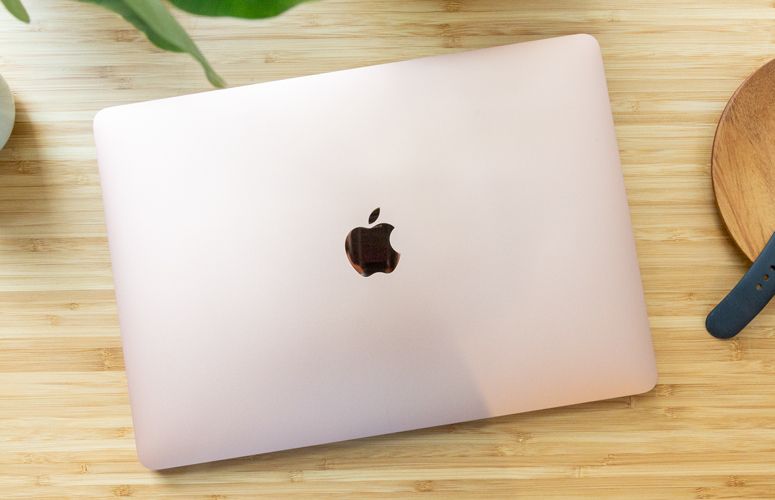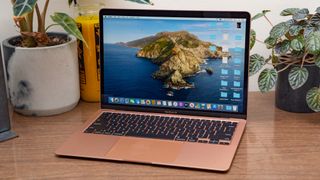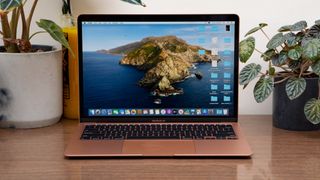MacBook Air 2020 vs. MacBook Air 2019: Should you upgrade?
Is the MacBook Air 2020 enough of an upgrade?

The long-awaited MacBook Air 2020 definitely ticks some of the boxes we were hoping to see addressed with the MacBook Air (2019).
Obviously, the new Magic Keyboard is at top of mind for many buyers after years of unreliable and uncomfortable butterfly keys. But what else does the new MacBook Air do to set itself apart from previous models?
Here's a look at how the MacBook Air (2020) stacks up against last year's MacBook Air and our recommendation on who should upgrade.
- MacBook Air 2020 vs. Dell XPS 13: Does Apple's new laptop take the crown?
- Best MacBook deals of March 2020
- Apple unveils new iPad Pro (2020) — finally, a laptop replacement
Price and availability: MacBook Air (2020) vs. MacBook Air (2019)
Perhaps the biggest surprise of the MacBook Air (2020) is the new $999 price, which is $100 cheaper than its predecessor. Keep in mind, though, that the base 2020 model has a Core i3 CPU and a 256GB SSD compared with a Core i5 CPU and a 128GB SSD on the previous version.
This is the second year in a row that the MacBook Air has dropped its starting price, bringing it below $1,000 for the first time since the introduction of the 2018 model. If you qualify for an education discount, the price drops all the way down to $899.
The MacBook Air (2020) is already shipping from Apple and is available to order from most major retailers.
Winner: MacBook Air (2020). Hard to argue with a $100 discount and, as you'll see, storage space has been bumped up as well.
Stay in the know with Laptop Mag
Get our in-depth reviews, helpful tips, great deals, and the biggest news stories delivered to your inbox.
Specs and features: MacBook Air (2020) vs. MacBook Air (2019)
| Row 0 - Cell 0 | MacBook Air 2020 | MacBook Air 2019 |
| CPU | 1.1-GHz 10th gen Intel Core i3 | 1.6-GHz 8th gen Intel Core i5 |
| RAM | 8GB LPDDR4X | 8GB LPDDR3 |
| Display | 13.3 (2560 x 1600) True Tone | 13.3 (2560 x 1600) True Tone |
| Ports | 2 Thunderbolt 3 USB-C | 2 Thunderbolt 3 USB-C |
| Graphics | Intel Iris Plus | Intel UHD Graphics 617 |
| Storage | 256GB | 128GB |
| Battery life | 11 hours (rated) | 12 hours (rated), 8:51 (tested) |
| Dimensions | 12 x 8.4 x 0.6 inches | 12 x 8.4 x 0.6 inches |
| Weight | 2.8 pounds | 2.75 pounds |
Winner: MacBook Air (2020). There are quite a few shared features between the two laptops, but doubling the base storage to 256GB and adding 10th Gen CPUs with improved Intel Iris Plus graphics makes the MacBook Air (2020) a clear upgrade in the specs department.
Design: MacBook Air (2020) vs. MacBook Air (2019)
Apple made no significant design changes this year to the MacBook Air; The iconic aluminum unibody design isn’t going anywhere for the immediate future.

Side-by-side with the MacBook Air (2019), the one change you might notice is that the MacBook Air (2020) is just slightly thicker at 0.63 inches versus the 0.61 inches of last year’s model. This also accounts for the increased weight, going from 2.75 pounds up to 2.8 pounds.
Winner: MacBook Air (2019). There are only slight differences in the designs (see keyboard section below), but we give this round to the older model because the MacBook Air 2020 is a little thicker and heavier.
Keyboard and touchpad: MacBook Air (2020) vs. MacBook Air (2019)
By far, the most eagerly anticipated update is the new MacBook Air's Magic Keyboard with its oh-so functional scissor switches. This replaces the unreliable butterfly switches used in the MacBook Air since the 2018 redesign.
We probably don’t have to convince you of the superiority of the new scissor key design, but the Laptop Mag staff did do a side-by-side comparison after the 16-inch MacBook Pro was released and unanimously sided with the Magic Keyboard.

Not only is the new Magic Keyboard a more pleasant typing experience day-to-day, but it should keep working reliably for years to come. The MacBook Air remains free of the TouchBar, with just the Touch ID fingerprint reader in the top-right corner of the keyboard.
The one other notable change to the keyboard is the return of the inverted T arrow keys, which were banished in the 2018 redesign. This makes finding these keys by touch much easier.
The large Force Touch trackpad on the MacBook Air (2020) remains identical to its predecessor, which was already best-in-class. No complaints there.
Winner: MacBook Air (2020). We've probably said enough about it already, but yes the new keyboard is a massive win for the MacBook Air (2020).
Ports: MacBook Air (2020) vs. MacBook Air (2019)
No changes were made here; the MacBook Air (2020) has the same dual Thunderbolt 3 (USB-C) ports and 3.5mm headphone jack selection as the MacBook Air (2019).
While one or two more USB-C ports would be welcome, Apple, at least, didn’t take anything away.
Winner: Draw.
Display: MacBook Air (2020) vs. MacBook Air (2019)
There were no major changes made to the MacBook Air's (2020) display, which isn't a complaint. The panel was one of our favorite features of the MacBook Air (2019).

The MacBook Air display went “Retina” in 2018 (2560 x 1600-pixels to be exact) and the MacBook Air (2019) introduced the “True Tone” display that automatically makes adjustments to the color temperature of the screen last year. This new 2020 model has all the same features.
In our testing, however, the MacBook Air (2020) did show some marked improvement over last year's Air.
Our colorimeter rated the MacBook Air's screen for producing 113% of the sRGB spectrum, still below the premium laptop average of 129%, but up from the 100% that the previous Air achieved and closer to the XPS 13 (4K: 119%; 1080p: 126%).
The brightness of the MacBook Air (2020) screen also saw a positive boost in our lab tests, with an average of 386 nits, beyond the 346 average for premium laptops. It still doesn't hold up to the 428 nits of the 13-inch MacBook Pro, but it has eclipsed the XPS 13 (4K 375 nites; 1080p: 357 nits).
Winner: MacBook Air (2020). While the basic specs remain the same for the MacBook Air (2020) the truth is in the testing and the panel is a solid step up from last year.
Performance and graphics: MacBook Air (2020) vs. MacBook Air (2019)
The MacBook Air (2020) makes the leap to 10th Gen Intel Ice Lake processors, up from the 8th Gen Intel Coffee Lake processors found in the MacBook Air (2019). Unfortunately, these are still Y-series Intel processors instead of the more powerful U-Series found in the Dell XPS 13.
According to Apple, the integrated Intel Iris Plus graphics result in an 80% graphics performance bump versus the MacBook Air (2019). Of course, we’ll have to see how this pans out in our own testing.
Notably, the base model MacBook Air (2020) only offers a core i3 processor compared with the Core i5 from the base MacBook Air (2019). Apple also added a Core i7 option, so the MacBook Air (2020) has a much wider range of performance options than we’ve seen in recent years.
In our testing of the core i3 MacBook Air (2020) it definitely shows some improvement over the 2019 Air. In our Handbrake video-editing test, the MacBook Air (2020) bested last year's model by almost 9 minutes. At 27 minutes and 10 seconds it is still behind the 21:55 category average, but a much more respectable effort.
We have also noted a boost in SSD performance with a write-speed rate of 1,359 MBps on the Blackmagic Disk Speed Test, which is faster than even the MacBook Pro 13 at 1,220 MBps and considerably faster than the MacBook Air (2019) at 1,011 MBps.
Winner: MacBook Air (2020). While the move to a base core i3 processor is a little disconcerting, the jump from an 8th Gen to a 10th Gen Intel processor along with the faster SSD appears to more than make up for it based on our testing. Upgrading to one of the higher-end processor options will make it considerably (up to 2x according to Apple) faster than the MacBook Air (2019).
Battery life: MacBook Air (2020) vs. MacBook Air (2019)
Despite the updated processors and identical battery size (49.9Wh), the MacBook Air (2020) actually loses about an hour of battery life when compared to last year’s model, according to Apple.
Apple claims 11 hours of “wireless web” use for the MacBook Air (2020), which is down from 12 hours with the MacBook Air (2019). This would still be an acceptable result for the category, but we’ll be interested to see if this holds true in our testing.
Winner: MacBook Air (2019). One of the few backslides of the MacBook Air (2020), although to be clear, this is based on Apple's claimed battery life. Last year's MacBook Air didn't live up to those claims, so it's possible this moves the MacBook Air (2020) into the win column once we are done testing it.
Outlook: MacBook Air (2020) vs. MacBook Air (2019)
Anyone who has owned or owns one of the butterfly keyboard MacBook models would tell you that the keyboard alone is reason enough to upgrade, and it would be hard to disagree there. Gone are the reliability concerns, and most users are going to find it more comfortable to type on as well.
Additionally, most of the MacBook Air's (2020) internals -- CPU, RAM and graphics -- were upgraded and based on our tests will deliver a better experience even with the base core i3 processor.
Yes, the MacBook Air (2020) did get slightly thicker and heavier, but it's a barely perceptible increase and won't make a difference when carrying the laptop in your bag.
Winner: MacBook Air (2020). All in all, it's an easy win for the MacBook Air (2020) over the MacBook Air (2019). If you have been holding off for the last few years of butterfly keyboards, now is a great time to buy. For owners of the 2018 or 2019 MacBook Air, the CPU boost and new keyboard still make this a worthwhile upgrade, but as your keyboard is still covered under Apple's warranty program, it's understandable if you want to hold off for a more significant redesign.
Sean Riley has been covering tech professionally for over a decade now. Most of that time was as a freelancer covering varied topics including phones, wearables, tablets, smart home devices, laptops, AR, VR, mobile payments, fintech, and more. Sean is the resident mobile expert at Laptop Mag, specializing in phones and wearables, you'll find plenty of news, reviews, how-to, and opinion pieces on these subjects from him here. But Laptop Mag has also proven a perfect fit for that broad range of interests with reviews and news on the latest laptops, VR games, and computer accessories along with coverage on everything from NFTs to cybersecurity and more.
